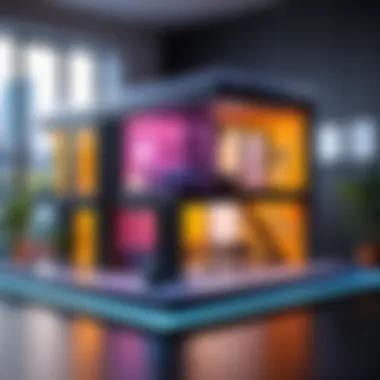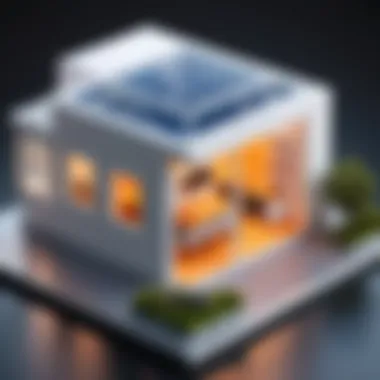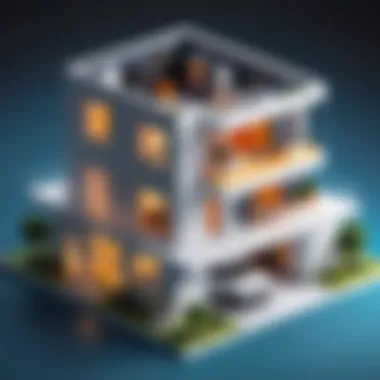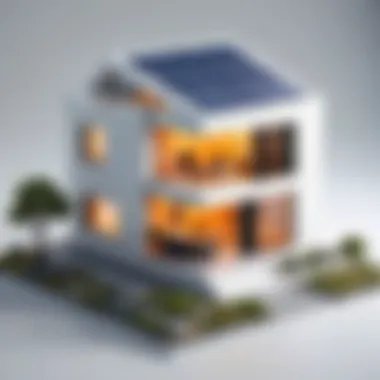Unlock the Path to Acquiring a 3D Printed Home: A Comprehensive Guide


Tech Trend Analysis
In the realm of cutting-edge construction methodologies, 3D printed houses have emerged as a revolutionary trend. The amalgamation of technology and architecture has paved the way for unparalleled efficiency and innovation in the housing sector. Consumers are increasingly intrigued by the prospects offered by 3D printed homes. The ability to customize designs, reduce construction time, and enhance sustainability resonates strongly with those seeking modern, eco-friendly living solutions. Looking ahead, the future holds even greater possibilities. With ongoing advancements in 3D printing technology, we can anticipate a shift towards more affordable and accessible housing options, ultimately reshaping the traditional landscape of home construction.
Product Reviews
When delving into the intricacies of 3D printed houses, it's essential to dissect the key players in the market. The products in focus showcase a fusion of state-of-the-art machinery and innovative design software. Their features encompass customizable architectural elements, rapid build times, and sustainable construction materials. Through performance analysis, these advancements prove to be formidable contenders in the realm of modern housing solutions. However, every innovation comes with its set of pros and cons. While 3D printed houses offer unmatched efficiency and design flexibility, challenges related to compatibility with local regulations and scalability pose potential concerns. Nevertheless, a balanced recommendation would emphasize the progressive nature of these products, heralding a new era in housing technology.
How-To Guides
Embarking on the journey of obtaining a 3D printed house demands a systematic approach. First and foremost, understanding the basics of 3D printing technology is imperative. Subsequently, a step-by-step guide illuminating the process of collaborating with architects, selecting suitable designs, and customizing elements according to personal preferences becomes indispensable. Alongside, indispensable tips and tricks can aid in optimizing the construction process, ensuring a seamless transition from design concept to full realization. Inevitably, despite careful planning, challenges may arise. From addressing structural integrity concerns to navigating complex regulations, troubleshooting strategies are essential to overcoming obstacles and achieving the desired outcome.
Industry Updates
To comprehend the impact of 3D printed houses, one must stay abreast of recent developments in the tech industry. The confluence of innovation and sustainability has spurred notable advancements, influencing market trends and consumer behaviors. Businesses are increasingly investing in 3D printing for construction, signaling a shift towards more efficient and eco-conscious practices. For consumers, this translates into a wider array of customizable housing solutions and a reduction in traditional construction limitations. As the industry continues to evolve, it is crucial for stakeholders to adapt to these changes and embrace the transformative power of 3D printed housing solutions.
Preamble to 3D Printed Houses
In the realm of modern construction methods, the advent of 3D printed houses has sparked a revolution. This section delves into the fundamental aspects of 3D printed houses, shedding light on their significance in reshaping the future of architecture and home-building. As we explore the intricate process of 3D printing homes layer by layer, it becomes evident that this innovative technology is not merely a trend but a paradigm shift in the realm of construction.
Understanding the Concept of 3D Printed Houses
Definition and Background
The foundation of 3D printed houses lies in the fusion of technology and traditional construction practices. By extruding material layer upon layer based on digital designs, these structures challenge conventional building techniques. The allure of rapid construction timelines and cost-effective methods embodies the essence of 3D printed houses, marking a departure from traditional brick-and-mortar approaches. This evolution promises to redefine the very fabric of architecture by introducing a harmonious blend of creativity and efficiency into the construction domain.
Benefits and Advantages
The advantages of 3D printed houses extend beyond mere expediency. By harnessing this technology, builders can actualize intricate geometries and customized designs with unparalleled precision. The eco-friendly nature of 3D printing in construction minimizes material wastage, aligning with sustainable practices. Additionally, the scalability and adaptability of these structures cater to diverse housing needs and architectural visions, standing as a testament to innovation in the construction landscape.
Technological Framework of 3D Printing in Construction
Materials Used in 3D Printing
At the core of 3D printing lies a diverse range of construction materials, from concrete blends to biodegradable polymers. These materials form the building blocks of futuristic abodes, offering a spectrum of characteristics like durability, flexibility, and thermal efficiency. The strategic selection of these materials ensures structural integrity while fostering creativity in architectural design, underscoring the versatility of 3D printed construction.
Types of 3D Printing Technologies


The realm of 3D printing technologies presents a myriad of options, from Fused Deposition Modeling (FDM) to Selective Laser Sintering (SLS). Each technique brings forth unique attributes, including speed, precision, and layering capabilities, thus shaping the construction landscape. By navigating through this technological labyrinth, builders can tailor their approach to match project requirements, opening doors to endless possibilities in the realm of 3D printed housing.
Current State and Future Prospects of 3D Printed Housing
Global Initiatives and Projects
Across the globe, visionary initiatives and projects are harnessing the potential of 3D printed housing to address housing crises and environmental concerns. These endeavors showcase the feasibility and scalability of this technology, setting the stage for a revolution in how we dwell and interact with our living spaces. The global spotlight on 3D printed dwellings underscores the transformative power of innovation within the construction industry.
Potential Impact on the Construction Industry
The potential impact of 3D printed housing on the construction industry transcends mere convenience. From reducing labor costs to expediting project timelines, this innovation streamlines construction processes while fostering creativity in architectural design. By embracing 3D printing, the construction sector paves the way for sustainable practices and groundbreaking methodologies, signaling a seismic shift in how we conceptualize and realize housing structures.
Practical Steps to Obtain a 3D Printed House: A Detailed Guide
3D printed houses represent the pinnacle of technological innovation in the construction industry. The practical steps needed to obtain a 3D printed house encompass a meticulous process that involves thorough research, precise planning, and thoughtful execution. Delving into the realm of 3D printed housing requires an understanding of futuristic concepts and cutting-edge methodologies. This section meticulously outlines the essential elements, benefits, and considerations associated with procuring a 3D printed house, offering invaluable insights for individuals intrigued by this avant-garde construction approach.
Research and Planning Phase: Paving the Path to 3D Printed Housing
Identifying Suitable Providers: The Key to Successful Implementation
Identifying suitable providers is a crucial aspect of the research and planning phase when embarking on a 3D printed housing project. This intricate process involves evaluating potential service providers based on their expertise, track record, and technological capabilities. Opting for reputable and experienced providers ensures a seamless transition from conceptualization to realization, guaranteeing a high-quality end product that aligns with your vision. However, choosing the right provider necessitates a comprehensive analysis of their unique features and considerations, weighing the advantages and disadvantages to make an informed decision.
Budgeting and Financing Options: Empowering Your 3D Printed House Vision
Budgeting and financing options play a pivotal role in the success of a 3D printed housing endeavor. Careful consideration of financial aspects such as cost estimation, funding sources, and expenditure planning is imperative to ensure a feasible and sustainable project progression. Understanding the unique features of different budgeting and financing options enables individuals to tailor their financial approach to suit their specific needs and constraints, enhancing the overall viability and longevity of the 3D printed house project.
Customization and Design Considerations: Crafting Your Dream 3D Printed Home
Tailoring the Design to Your Needs: A Personalized Approach to Housing
Tailoring the design of a 3D printed house to individual needs epitomizes the essence of customization in modern construction practices. This tailored approach allows homeowners to create spaces that resonate with their lifestyle preferences, aesthetic sensibilities, and functional requirements. The key characteristic of tailoring the design lies in its ability to transform abstract visions into tangible realities, emphasizing user-centric design principles to enhance overall satisfaction and comfort.
Incorporating Sustainable Features: Building Responsibly for the Future
Incorporating sustainable features into the design of a 3D printed house exemplifies a commitment to environmental consciousness and long-term sustainability. By integrating eco-friendly materials, energy-efficient systems, and passive design strategies, homeowners can reduce their carbon footprint and embrace green living practices. The unique feature of incorporating sustainable features lies in the harmonious balance between functional efficacy and ecological responsibility, offering dwellers a space that prioritizes both comfort and conservation.
Execution and Construction Process: Turning Blueprints Into Reality


Site Preparation and Foundation: Laying the Groundwork for Success
Site preparation and foundation establishment form the cornerstone of the execution phase in 3D printed housing projects. This critical stage involves site analysis, ground leveling, and foundation construction to create a stable and secure base for the subsequent printing processes. The unique feature of meticulous site preparation lies in its profound impact on the structural integrity and durability of the 3D printed house, emphasizing the importance of precision and attention to detail.
Monitoring the Printing Progress: Ensuring Precision and Quality Control
Monitoring the printing progress during the construction phase is essential to guaranteeing the accuracy and quality of the final output. This monitoring process involves real-time oversight of the printing parameters, structural coherence, and material adherence to ensure consistency and uniformity throughout the printing process. The key characteristic of monitoring lies in its proactive approach to error detection and rectification, mitigating potential risks and enhancing the overall efficiency of the 3D printing operation.
Post-Construction Maintenance and Upkeep: Sustaining the Longevity of Your 3D Printed Home
Ensuring Structural Integrity: Preserving the Strength and Stability of Your Home
Ensuring the structural integrity of a 3D printed house requires diligent upkeep and proactive maintenance practices. Regular inspections, structural evaluations, and timely repairs are essential to address potential vulnerabilities and safeguard the longevity of the structure. The unique feature of structural integrity maintenance lies in its preventative nature, mitigating risks of structural failures or safety hazards through early detection and intervention.
Implementing Regular Inspections: A Proactive Approach to Home Preservation
Implementing regular inspections post-construction is a proactive strategy to detect and address any potential issues before they escalate. Regular inspections encompass thorough assessments of the building's components, systems, and functionality to identify signs of wear, damage, or deterioration. The key characteristic of regular inspections lies in their ability to prolong the lifespan of the 3D printed house, ensuring optimal performance and habitability for years to come.
Challenges and Considerations in 3D Printed Housing
As we delve into the realm of 3D printed housing, we encounter a myriad of challenges and considerations that underscore the importance of meticulous planning and execution. Understanding these complexities is crucial for anyone embarking on the journey of obtaining a 3D printed house. From regulatory hurdles to environmental impacts, each facet requires careful navigation to ensure the success of the project.
Regulatory Hurdles and Compliance Issues
Building Codes and Permits
Exploring the intricate landscape of building codes and permits reveals a critical aspect of 3D printed housing projects. The adherence to specific regulations and standards is paramount in achieving structural integrity and safety. By meticulously following these guidelines, one can navigate the legal framework with precision and professionalism. The unique feature of building codes and permits lies in their ability to provide a solid foundation for construction projects, ensuring compliance with industry norms and governmental requirements. While these codes may present challenges in terms of complexity and time-consuming approvals, their ultimate benefit lies in the safeguarding of both occupants and structures.
Legal Implications of 3D Printing in Construction
Unraveling the legal implications surrounding 3D printing in construction sheds light on a fundamental aspect of this innovative technology. Addressing issues such as intellectual property rights, liability, and warranty considerations is essential for balancing innovation with legalities. The distinctive feature of legal implications in 3D printing lies in their capacity to define ownership and responsibility within a rapidly evolving industry. While navigating these legal waters may pose challenges in terms of ambiguity and evolving legislation, understanding the legal landscape can mitigate risks and ensure accountability throughout the construction process.
Environmental Impact and Sustainability Factors
In the quest for sustainable construction practices, environmental impact and resource efficiency play pivotal roles in shaping 3D printed housing projects. Delving into these factors illuminates the broader implications of construction activities on the environment and future generations. By prioritizing resource efficiency, builders can minimize waste and optimize materials usage, aligning with eco-friendly practices. The unique feature of resource efficiency lies in its ability to foster cost-effective and environmentally conscious construction methodologies. While challenges such as sourcing sustainable materials and implementing efficient technologies may arise, the long-term advantages of resource efficiency far outweigh any initial hurdles.
Waste Management Strategies


Effective waste management strategies stand at the forefront of environmentally sustainable construction practices. By devising comprehensive plans for waste reduction, recycling, and disposal, builders can minimize their ecological footprint and promote a circular economy. The distinctive characteristic of waste management lies in its capacity to transform waste into valuable resources, enhancing the overall sustainability of construction projects. While challenges in waste sorting and disposal logistics may pose logistical hurdles, the advantages of implementing robust waste management strategies are manifold, contributing to a cleaner and greener construction industry.
Social Acceptance and Perception of 3D Printed Housing
Beyond the technical intricacies of 3D printing, social acceptance and community engagement form integral components of successful 3D printed housing projects. Understanding public perceptions and addressing concerns are vital for fostering trust and acceptance within the community. The key characteristic of community engagement lies in its ability to create a dialogue between builders, residents, and stakeholders, fostering a sense of collaboration and transparency. While challenges such as misinformation and resistance to new technologies may impede progress, effective community engagement can build a strong foundation for inclusive and sustainable construction practices.
Addressing Concerns and Myths
Debunking myths and addressing concerns surrounding 3D printed housing is essential for dispelling misconceptions and building confidence in the technology. By transparently addressing common fears and uncertainties, builders can educate the public and cultivate a culture of informed decision-making. The unique feature of addressing concerns and myths lies in its potential to bridge the gap between perception and reality, fostering a nuanced understanding of 3D printing in construction. While challenges such as misinformation and skepticism may pose communication barriers, the benefits of transparent communication and myth-busting efforts are invaluable in shaping a positive narrative around 3D printed housing projects.
Future Trends and Innovations in 3D Printed Construction
In the realm of 3D printed construction, staying abreast of future trends and innovations is paramount to drive progress and efficiency. As technology continues to evolve, embracing emerging trends is not only beneficial but necessary for industry advancement. Future trends offer insights into what lies ahead, paving the way for novel developments and improved methodologies. Exploring these trends can provide a roadmap for growth and innovation in the 3D printing domain.
Emerging Technologies and Experimental Applications
Robotic Construction Systems
Robotic Construction Systems represent a cutting-edge approach to building through automated processes, revolutionizing traditional construction methods. The key characteristic of these systems lies in their precision and efficiency, streamlining the construction process significantly. By harnessing robotics, construction tasks can be completed with unparalleled accuracy and speed, reducing human error and optimizing resource utilization. The unique feature of Robotic Construction Systems is their ability to operate autonomously, enhancing productivity and ensuring consistent quality output. While their advantages include increased productivity and safety, challenges such as initial setup costs and maintenance complexities must be carefully considered.
Integration of Smart Home Features
The integration of smart home features in 3D printed construction exemplifies the fusion of technology and functionality. Smart home features encompass advanced systems that enable automation and control of various household functions. Their key characteristic lies in enhancing comfort, convenience, and energy efficiency within residential spaces. Embracing smart home features in 3D printed houses offers residents greater control over their living environment through interconnected devices and systems. The unique feature of smart home integration is its ability to customize living experiences and optimize resource usage. While advantages include energy savings and improved lifestyle quality, challenges such as cybersecurity risks and compatibility issues need to be addressed.
Collaborative Research and Industry Partnerships
Knowledge Sharing Networks
Knowledge sharing networks play a crucial role in fostering collaboration and innovation within the 3D printed construction sector. The key characteristic of these networks is their capacity to facilitate information exchange and expertise pooling among industry stakeholders. By promoting open communication and shared learning, knowledge sharing networks accelerate technological advancements and best practices adoption. The unique feature of these networks is their ability to connect diverse professionals, researchers, and enthusiasts, fostering a rich ecosystem of ideas and insights. While advantages include accelerated innovation and problem-solving capabilities, challenges such as data security and information reliability require prudent management.
Cross-Sector Alliances
Cross-sector alliances form strategic partnerships that drive synergies and unlock new possibilities in 3D printed construction. The key characteristic of these alliances is their ability to combine diverse expertise and resources from different sectors to achieve common goals. By bridging industry divides and leveraging complementary strengths, cross-sector alliances stimulate innovation and holistic problem-solving approaches. The unique feature of these partnerships is their capacity to break silos and promote interdisciplinary collaboration, fostering holistic solutions to complex challenges. While advantages include diversified perspectives and enhanced creativity, challenges such as aligning disparate goals and managing collaborative dynamics need to be navigated.
Market Growth and Investment Opportunities
Investor Interest in 3D Printed Construction
Investor interest in 3D printed construction underscores the growing appeal and potential of this transformative technology within the investment community. The key characteristic of this interest is the recognition of 3D printing as a disruptive force in the construction industry, offering novel solutions and efficiencies. Investors are drawn to the scalability and versatility of 3D printed construction, seeing it as a promising avenue for long-term returns and innovation. The unique feature of investor interest lies in its ability to fuel research and development efforts, driving technological advancements and market expansion. While advantages include diversified funding sources and industry validation, challenges such as market volatility and regulatory uncertainties pose risks that necessitate careful navigation.
Economic Viability of Large-Scale Adoption
The economic viability of large-scale adoption of 3D printed construction is a critical consideration for industry stakeholders and decision-makers. The key characteristic of this viability lies in its potential to deliver cost savings, time efficiencies, and sustainability benefits compared to traditional construction methods. Large-scale adoption holds the promise of streamlining project timelines, reducing labor costs, and minimizing material wastage, leading to overall project cost reductions. The unique feature of economic viability in large-scale adoption is its transformative impact on project economics and industry competitiveness. While advantages include enhanced project feasibility and environmental sustainability, challenges such as regulatory constraints and market acceptance pose hurdles that require strategic planning and proactive mitigation.



